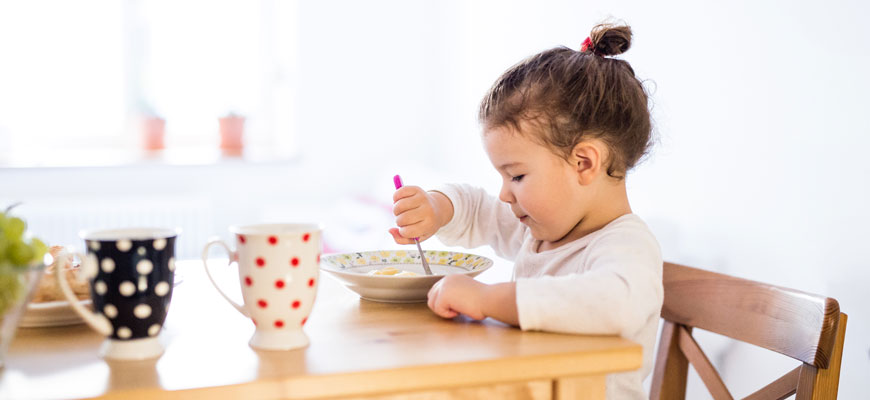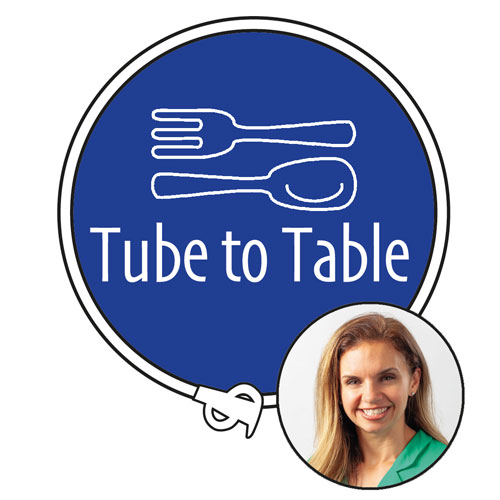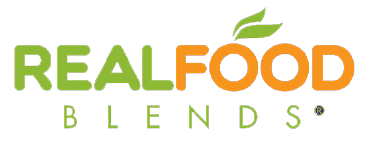
The Role of Real Food in Tube Weaning
Research supports increased interest in oral eating with blenderized diets

“My child is now eating Real Food Blends orally!”
This is a comment we get quite a bit and might be one of our very favorite “side effects” of using Real Food Blends in place of a typical tube-feeding formula. Aside from the anecdotal evidence we hear time and again, many of the studies about real food for people with feeding tubes note this “increased interest in oral eating.” Below, Aubrey Phelps, MS, RDN, PPCES, IFNCP, goes over different studies that show how using real food can help facilitate the transition to eating orally and what the results mean outside of a clinical setting. She also has personal experience with this topic—her daughter was able to transition from using Real Food Blends with her feeding tube to 100% oral eating!
by Aubrey Phelps, MS RDN, PPCES, IFNCP
Getting your child with a feeding tube to happily become an oral eater can seem like a monumental task. There are many factors that go into a successful tube-wean, but one often-overlooked aspect to tube-weaning is that introducing food through the tube prior to starting a wean can increase the chances of success. Aside from anecdotal evidence (including my own daughter!), two independent research studies have noted this impact:
“The parents of 17 of 33 children (52%) reported a 76% to 100% decrease in gagging and retching after their child started the PBGT diet… No parents reported that their child’s gagging or retching worsened on the PBGT diet”
“Nineteen children (57%) were reported to have an increase in oral intake on the pureed by gastrostomy tube (PBGT) diet… No child was reported to eat less by mouth after starting the PBGT diet”
“The decrease in gagging and retching on puréed feeds may have decreased oral aversion, making the child more receptive to eating by mouth”

Puree by gastrostomy tube diet improves gagging and retching in children with fundoplication
Pentiuk et al (2011) – Cincinnati Children’s Hospital Medical Center
This study looked at the use of purees through the g-tube, specifically for kids. To summarize the key take-aways quoted above, switching to a pureed real food diet improved reflux and retching in over half of the kids—this is one of the most common reported frustrations of parents with children using a tube and a prime reason for a switch to a J-tube. For that group, improvement was significant, ranging from almost completely stopping reflux and retching to being totally eliminated. And none of the kids had worsened symptoms when they switched. In other words, there’s a great chance switching to a blenderized/real food puree diet could improve your child’s vomiting and gagging and very little chance it could make things any worse (so you don’t really have anything to lose!).
This study also concluded that oral intake improved with a pureed tube-fed diet and that this improvement was likely thanks to the reduction in digestive discomfort. Because oral aversions are a huge contributor to tube-feeding and an obstacle to improving oral intake for a wean, this approach to tube-feeding may help lead the way to weaning or increasing oral intake as appropriate to the individual’s medical needs.
“Parents reported less limitation to food and drink intake with blenderized diets. This may reflect improved gastrointestinal tolerance of dietary components, increased perception of diversity of diet, or increased oral intake, as suggested by Gallagher et al”

Health outcomes and quality of life indices of children receiving blenderized feeds via enteral tube
Horn et al (2019) – Boston Children’s Hospital
And yet again, this study found that kids simply did better on blenderized diets, from a comfort standpoint, as well as oral intake. (If you are on the fence about trailing a blended diet like Real Food Blends, I would highly encourage you to read this entire study. It’s the largest done to date on blended diets and is a head-to-head comparison of formula-fed children to children fed real food. No surprise, those getting a wide variety of fruits & veggies fared much better!)
Why Does Real Food Often Increase Interest in Oral Eating?
Exactly why getting a variety of real food into the stomach through the tube seems to create this willingness to eat orally is debated. Improvements in reflux, vomiting, constipation/diarrhea, and lowering or eliminating medications to manage all these symptoms can all contribute to increased in eating orally. After all, who would want to eat if they feel sick or uncomfortable all the time?
It could also be from improvements in the gut microbiome, as one of the studies above supported. Each type of bacteria in your gut has a preference for certain kinds of foods–the “good guys” really, really like fiber, fruits, and vegetables. A real food diet encourages the growth of more of these good bacteria, which in turn, encourages a desire for more of the food that they like! Less healthy microbes prefer processed carbs/sugars, which most commercial tube-feeding formulas are quite high in. Improvement in microbiome balance also supports a happier digestive system, which can improve both digestion and immune health (and doesn’t it make sense that a kid who’s no longer sick all the time might have more interest in eating?). It’s important to note that in all these studies, the children were fed a varied, whole food diet exposing their bodies to a wide variety of food, smells, and ‘tastes.’
With all of these potential gains, there are really no reasons to NOT trial a blenderized diet like Real Food Blends if your child is over the age of 1 and has an intact and working digestive system. Even if it doesn’t increase oral intake, it will likely improve digestive comfort and will have a positive impact on the microbiome, which supports overall improved health! (And there’s a growing body of clinical support from major medical institutions showing that real food is good for kids – go figure!)
About the author

Aubrey Phelps, MS, RDN, PPCES, IFNCP is a registered integrative nutritionist specializing in perinatal and pediatric nutrition. She’s a momma to a former tubie who thrived on Real Food Blends before she weaned to a diverse, real food oral diet! Outside of her private practice, Aubrey consults for Growing Independent Eaters, a home-based tube-weaning program, as well as Real Food Blends.
Additional Information on Tube Weaning
Learn more about how real food through the feeding tube can help with the tube weaning process in this video from Marsha Dunn Klein, a pediatric occupational therapist who has spent a career specializing in pediatric feeding challenges.

Listen to our co-founder, Julie Bombacino, talk about the role of real food in tube weaning on the Tube to Table podcast from Thrive by Spectrum Pediatrics.






